Performance Analysis of a Full-Scale Desalination Plant with Reverse Osmosis Membranes for Irrigation
Abstract
:1. Introduction
2. Materials and Methods
3. Results
4. Conclusions
Author Contributions
Funding
Acknowledgments
Conflicts of Interest
References
- Tal, A. Addressing Desalination’s Carbon Footprint: The Israeli Experience. Water 2018, 10, 197. [Google Scholar] [CrossRef] [Green Version]
- Ruiz-Garcia, A.; De la Nuez, I. Feed Spacer Geometries and Permeability Coefficients. Effect on the Performance in BWRO Spriral-Wound Membrane Modules. Water 2019, 11, 152. [Google Scholar] [CrossRef] [Green Version]
- Kurihara, M. Seawater Reverse Osmosis Desalination. Membranes 2021, 11, 243. [Google Scholar] [CrossRef] [PubMed]
- Ruiz-García, A.; Melián-Martel, N.; Nuez, I. Short Review on Predicting Fouling in RO Desalination. Membranes 2017, 7, 62. [Google Scholar] [CrossRef] [PubMed] [Green Version]
- Leon, F.; Ramos, A.; Vaswani, J.; Mendieta, C.; Brito, S. Climate Change Mitigation Strategy through Membranes Replacement and Determination Methodology of Carbon Footprint in Reverse Osmosis RO Desalination Plants for Islands and Isolated Territories. Water 2021, 13, 293. [Google Scholar] [CrossRef]
- Kurihara, M.; Takeuchi, H. SWRO-PRO System in “Mega-ton Water System” for Energy Reduction and Low Environmental Impact. Water 2018, 10, 48. [Google Scholar] [CrossRef] [Green Version]
- Davenport, D.M.; Deshmukh, A.; Werber, J.R.; Elimelech, M. High-Pressure Reverse Osmosis for Energy-Efficient Hypersaline Brine Desalination: Current Status, Design Considerations, and Research Needs. Environ. Sci. Technol. Lett. 2018, 5, 467–475. [Google Scholar] [CrossRef]
- Patel, S.K.; Ritt, C.L.; Deshmukh, A.; Wang, Z.; Qin, M.; Epsztein, R. Menachem Elimelech. The relative insignificance of ad-vanced materials in enhancing the energy efficiency of desalination technologies. Energy Environ. Sci. 2020, 13, 1694–1710. [Google Scholar] [CrossRef] [Green Version]
- Boo, C.; Winton, R.K.; Conway, K.M.; Yip, N.Y. Membrane-less and Non-Evaporative Desalination of Hypersaline Brines by Temperature Swing Solvent Extraction. Environ. Sci. Technol. Lett. 2019, 6, 359–364. [Google Scholar] [CrossRef]
- Cohen, Y.; Semiat, R.; Rahardianto, A. A perspective on reverse osmosis water desalination: Quest for sustainability. AIChE J. 2017, 63, 1771–1784. [Google Scholar] [CrossRef]
- White, F. Mecánica de Fluidos; McGraw-Hill: New York, NY, USA, 2008. [Google Scholar]
- Burn, S.; Hoang, M.; Zarzo, D.; Olewniak, F.; Campos, E.; Bolto, B.; Barron, O. Desalination techniques—A review of the opportunities for desalination in agriculture. Desalination 2015, 364, 2–16. [Google Scholar] [CrossRef]
- León, F.A.; Ramos, A. Analysis of high efficiency membrane pilot testing for membrane design optimization. Desalination Water Treat. 2017, 73, 208–214. [Google Scholar] [CrossRef]
- Jiménez, C. Seawater temperature measured at the surface and at two depths (7 and 12 m) in one coral reef at Culebra Bay, Gulf of Papagayo, Costa Rica. Rev. Biol. Trop. 2001, 49, 153–161. [Google Scholar] [PubMed]
- Du, Y.; Liu, Y.; Xie, L.; Zhang, S. Economic, Energy, Exergo-Economic, and Environmental Analyses and Multiobjective Op-timization of Seawater Reverse Osmosis Desalination Systems with Boron Removal. Ind. Eng. Chem. Res. 2019, 58, 14193–14208. [Google Scholar] [CrossRef]
- Jafari, M.; Vanoppen, M.; van Agtmaal, J.M.C.; Cornelissen, E.R.; Vrouwenvelder, J.S.; Verliefde, A.; van Loosdrecht, M.C.M.; Picioreanu, C. Cost of founling in full-scale reverse osmosis nanofiltration installations in the Netherlands. Desalination 2021, 500, 114865. [Google Scholar] [CrossRef]
- Ghalavand, Y.; Hatamipour, M.S.; Rahimi, A. A review on energy consumption of desalination processes. Desalination Water Treat. 2014, 1–16. [Google Scholar] [CrossRef]
- Gude, V.G. Energy consumption and recovery in reverse osmosis. Desalination Water Treat. 2011, 36, 239–260. [Google Scholar] [CrossRef]
- Semiat, R. Energy Issues in Desalination Processes. Environ. Sci. Technol. 2008, 42, 8193–8201. [Google Scholar] [CrossRef]
- Akgul, D.; Mehmet, C.F.; Kayaalp, N. Cost analysis of sea water desalination with reverse osmosis in Turkey. Desalination 2008, 220, 123–131. [Google Scholar] [CrossRef]
- Koutsou, C.; Kritikos, E.; Karabelas, A.; Kostoglou, M. Analysis of temperature effects on the specific energy consumption in reverse osmosis desalination processes. Desalination 2019, 476, 114213. [Google Scholar] [CrossRef]
- Avlonitis, S.; Kouroumbas, K.; Vlachakis, N. Energy consumption and membrane replacement cost for seawater RO desalination plants. Desalination 2003, 157, 151–158. [Google Scholar] [CrossRef]
- Elmaadawy, K.; Kotb, M.; Elkadeem, M.R.; Sharshif, S.W.; Dan, A.; Moawad, A.; Liu, B. Optimal sizing and tech-no-enviroeconomic feasibility assessment of large-scale reverse osmosis desalination powered with hybrid renewable energy sources. Energy Convers. Manag. 2020, 224, 113377. [Google Scholar] [CrossRef]
- Busch, M.; Mickols, W. Reducing energy consumption in seawater desalination. Desalination 2004, 165, 299–312. [Google Scholar] [CrossRef]
- Voutchkov, N. Energy use for membrane seawater desalination—Current status and trends. Desalination 2018, 431, 2–14. [Google Scholar] [CrossRef]
- Wakeel, M.; Chen, B.; Hayat, T.; Alsaedi, A.; Ahmad, B. Energy consumption for water use cycles in different countries: A review. Appl. Energy 2016, 178, 868–885. [Google Scholar] [CrossRef]
- Altmann, T.; Das, R. Process improvement of sea water reverse osmosis (SWRO) and subsequent decarbonization. Desalination 2020, 499, 114791. [Google Scholar] [CrossRef]
- Wittholz, M.K.; O’Neill, B.K.; Colby, C.B.; Lewis, D. Estimating the cost of desalination plants using a cost database. Desalination 2008, 229, 10–20. [Google Scholar] [CrossRef]
- Heihsel, M.; Lenzen, M.; Malik, A.; Geschke, A. The carbon footprint of desalination. An input-output analysis of seawater reverse osmosis desalination in Australia 2005–2015. Desalination 2019, 454, 71–81. [Google Scholar] [CrossRef]
- Giwa, A.; Akther, N.; Dufour, V.M.; Hasan, S.W. A critical review on recent polymeric and nano-enhanced membranes for reverse osmosis process. RSC Adv. 2015, 6, 8134–8163. [Google Scholar] [CrossRef]
- Kim, J.; Park, K.; Yang, D.R.; Hong, S. A comprehensive review of energy consumption of sea water reverse osmosis desali-nation plants. Appl. Energy. 2019, 254, 113652. [Google Scholar] [CrossRef]
- Alanezi, A.A.; Altaee, A.; Sharif, A.O. The effect of energy recovery device and feed flow rate on the energy efficiency of reverse osmosis process. Chem. Eng. Res. Des. 2020, 158, 12–23. [Google Scholar] [CrossRef]
- Gualous, H.; Bouquain, D.; Berthon, A.; Kauffmann, J.M. Experimental study of supercapacitor serial resistance and capac-itance variations with temperature. J. Power Sources 2003, 123, 86–93. [Google Scholar] [CrossRef]
- El Brouji, H.; Vinassa, J.-M.; Briat, O.; Bertrand, N.; Woirgard, E. Ultracapacitors self discharge modelling using a physical description of porous electrode impedance. In Proceedings of the IEEE Vehicle Power and Propulsion Conference, Harbin, China, 3–5 September 2008. [Google Scholar]


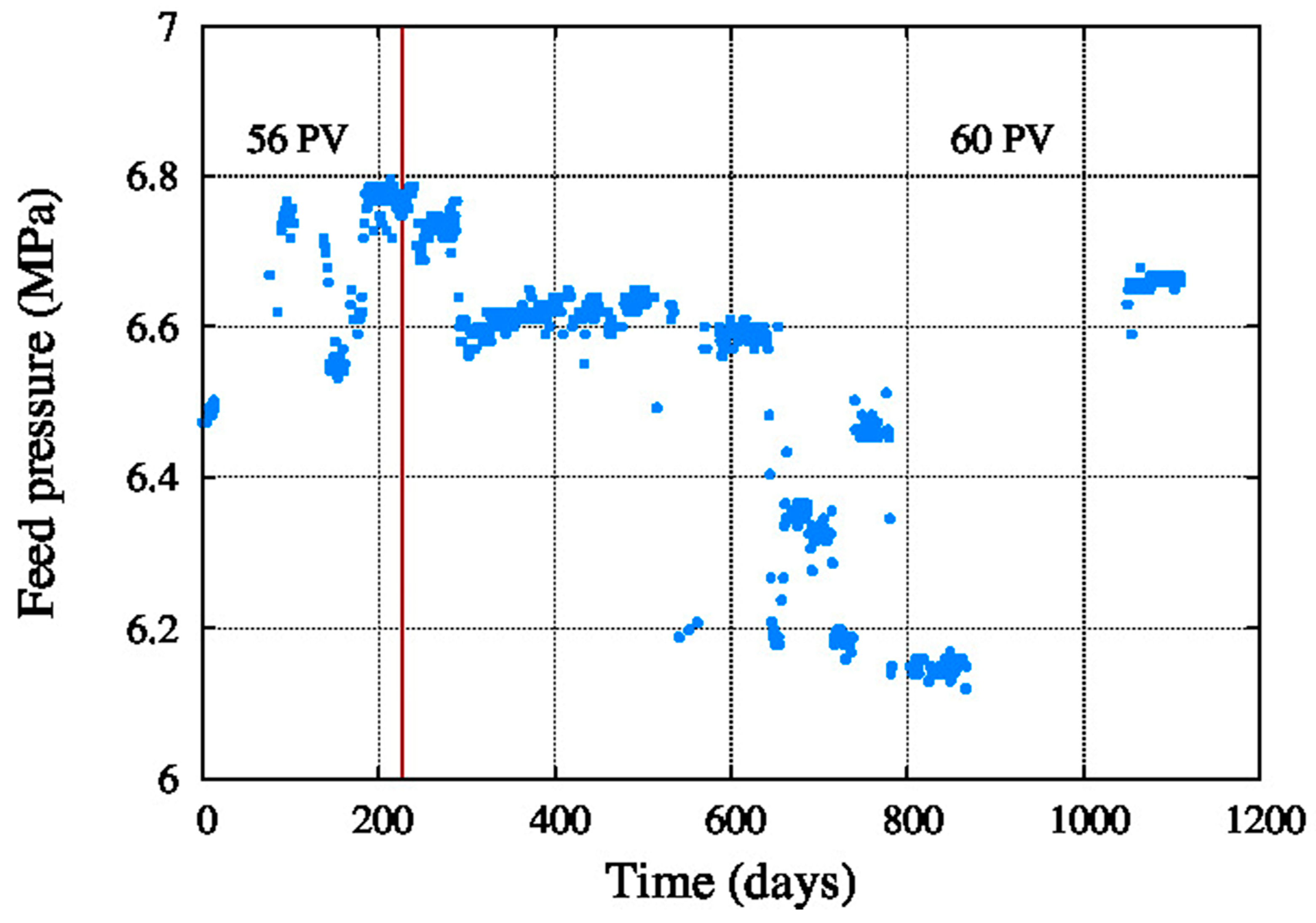
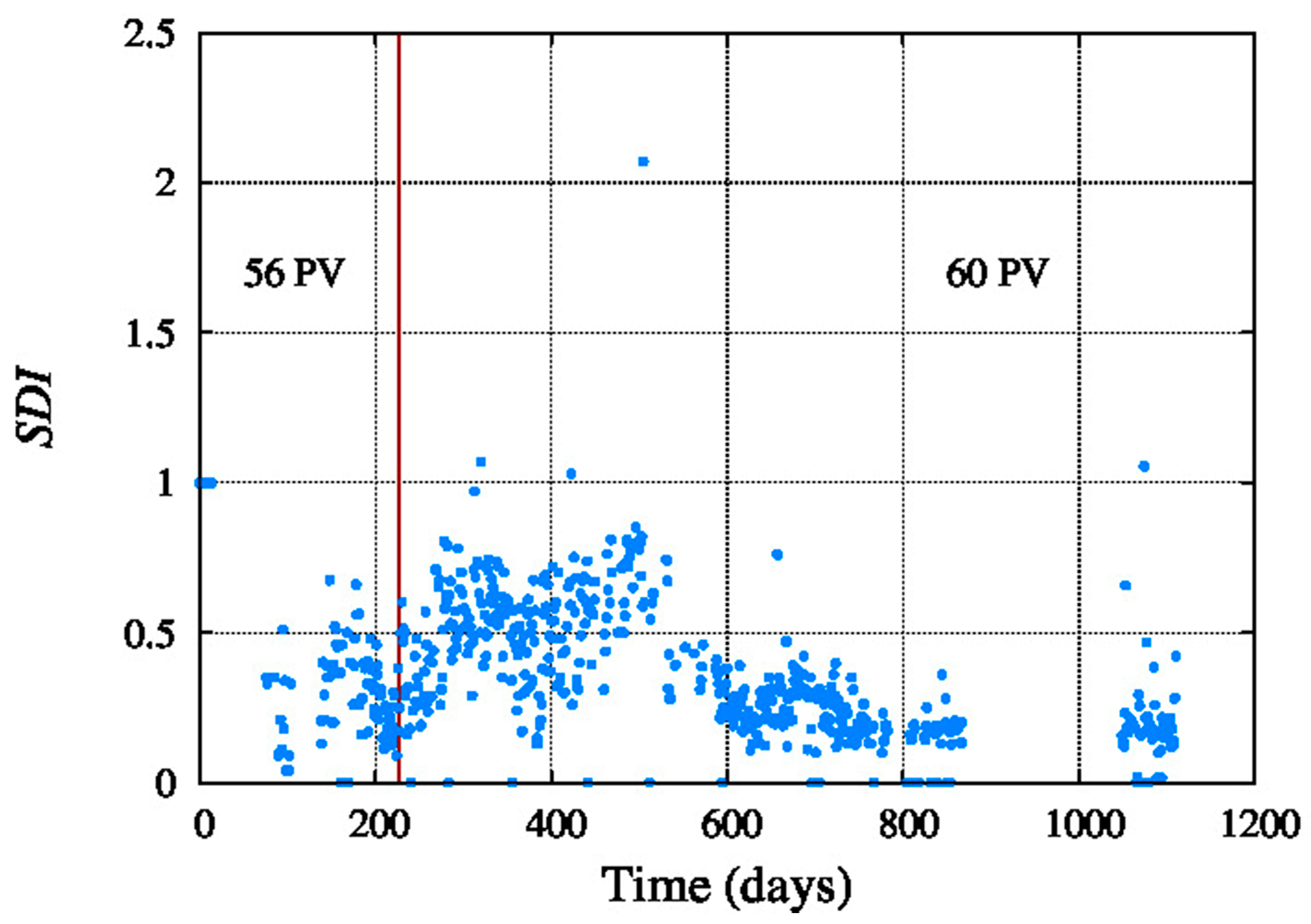
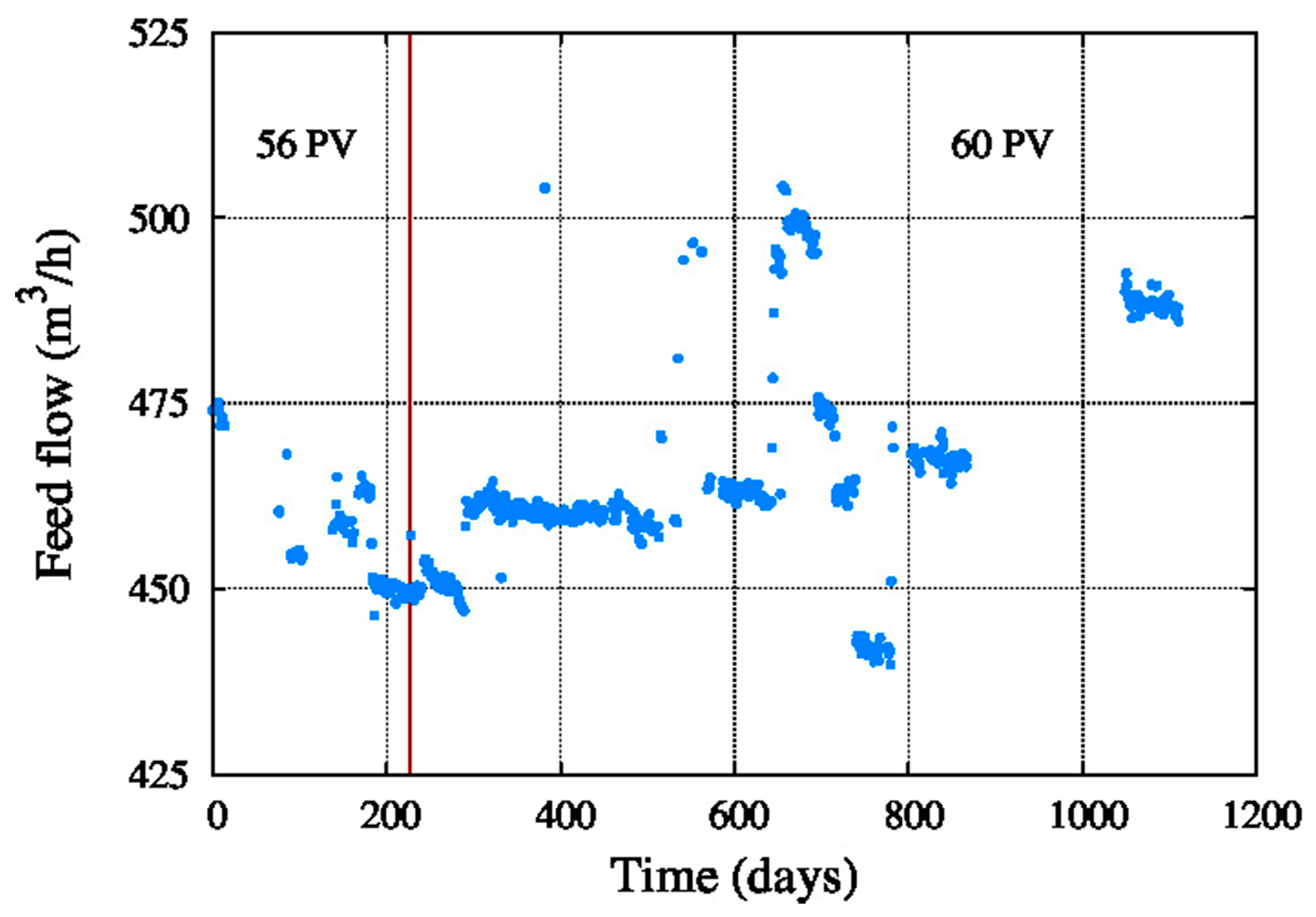


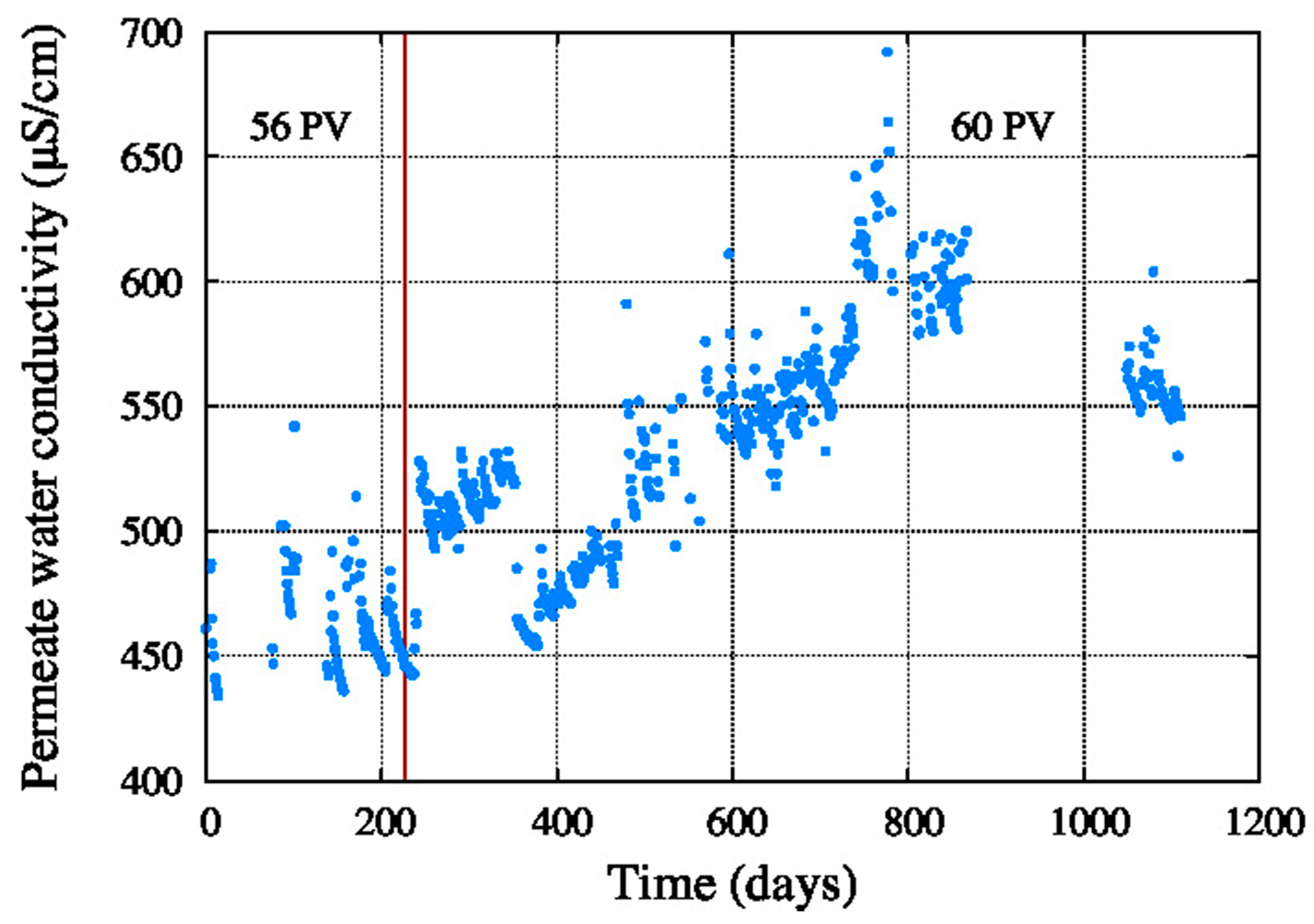
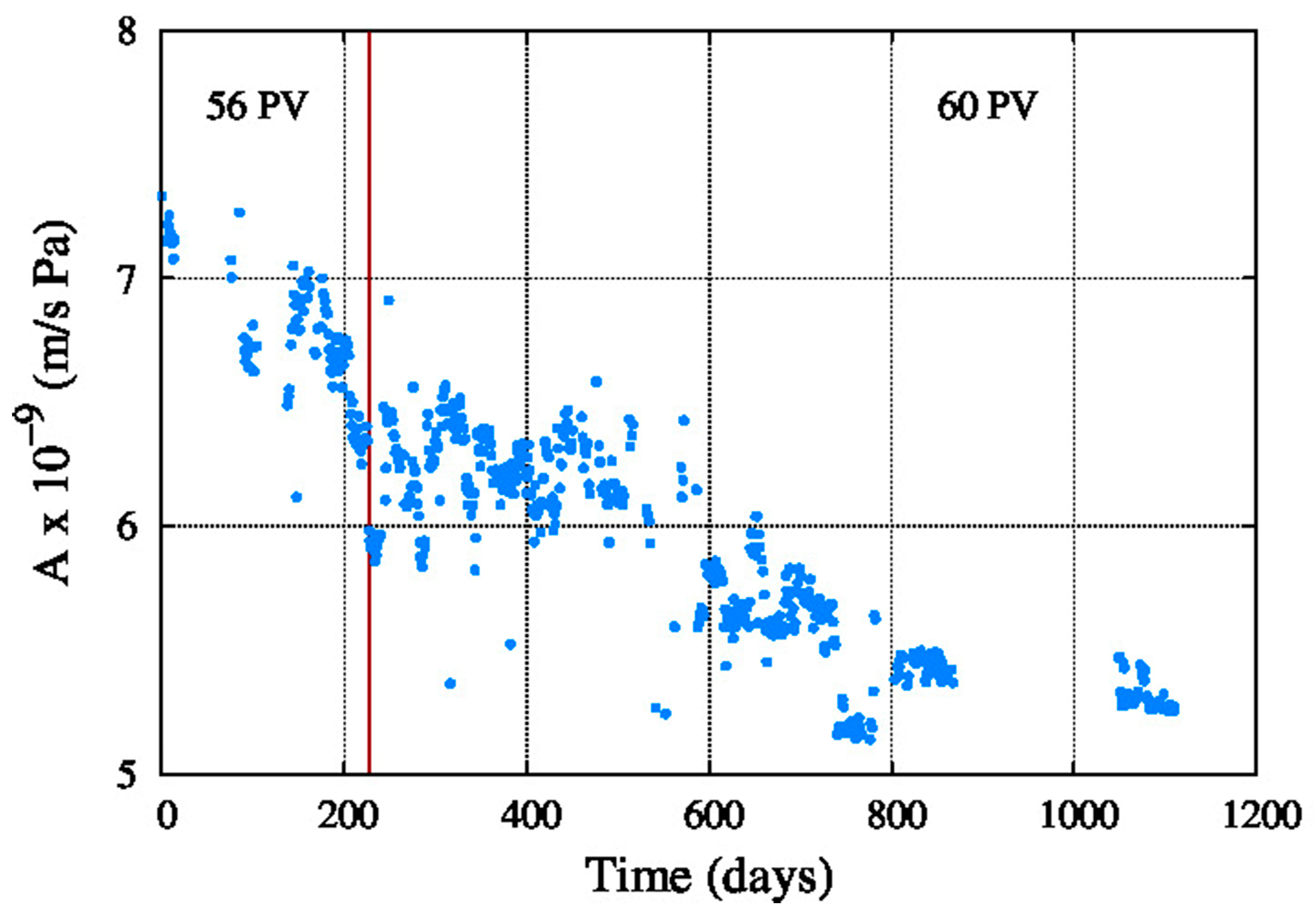
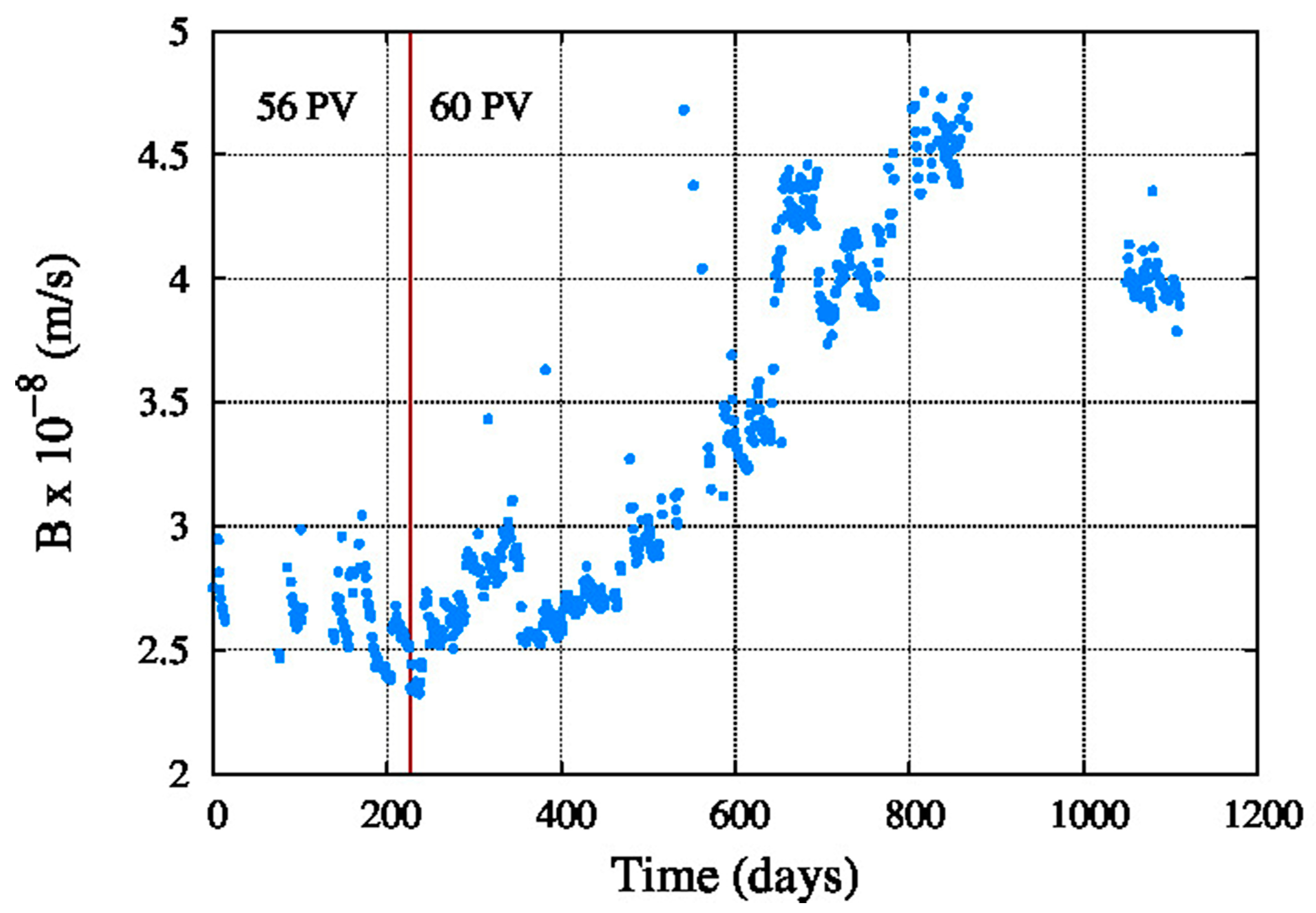
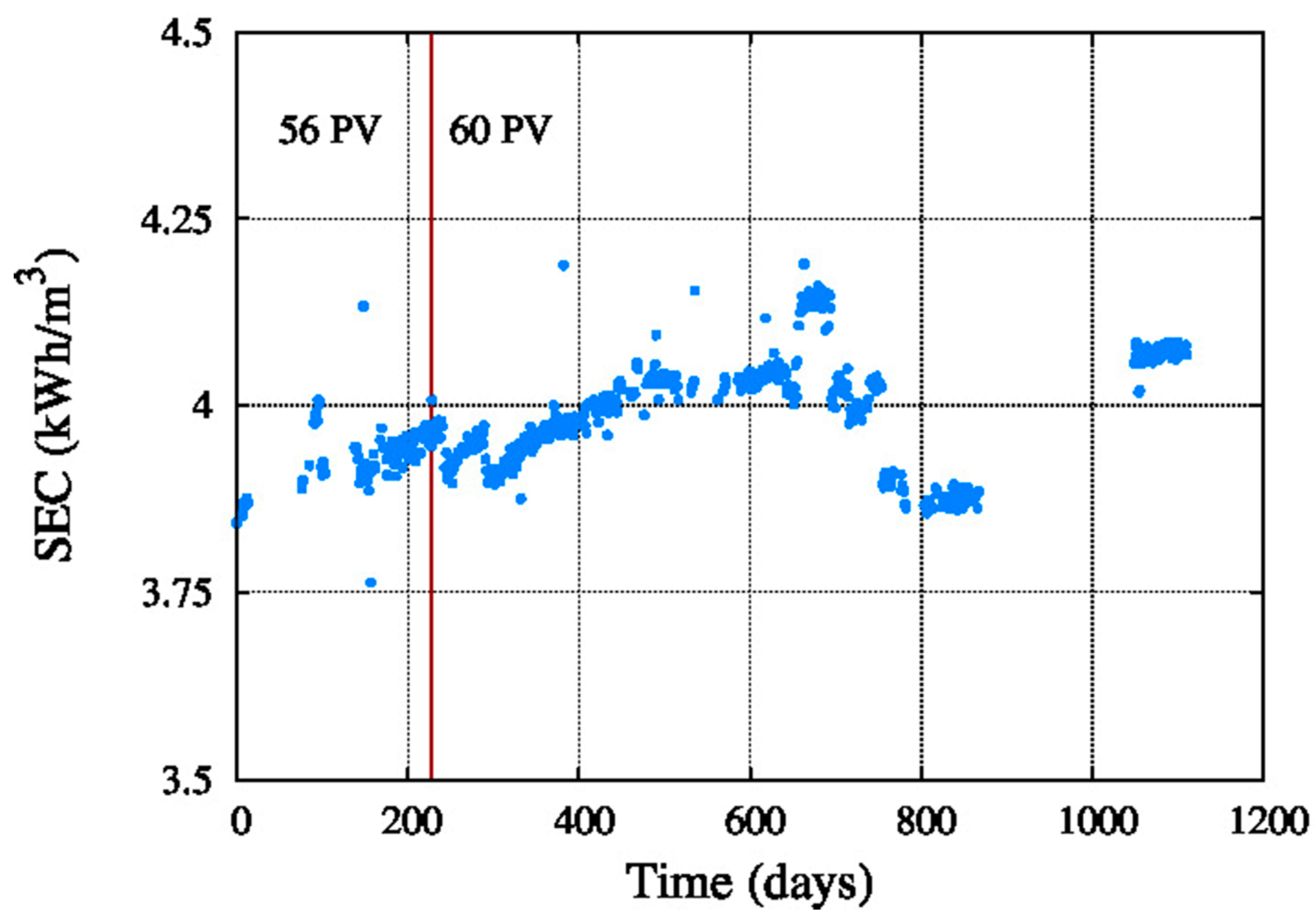
| Feed Water | Seawater |
|---|---|
| Salt rejection | 99.75% |
| Product Flow rate | 16.00 m3/day |
| Ion | Concentration mg/L |
|---|---|
| Ca2+ | 165 |
| Mg2+ | 306 |
| Na+ | 12,514 |
| K+ | 642 |
| HCO3- | 488 |
| SO42- | 1076 |
| NO3- | 308 |
| Cl- | 19,586 |
| SiO2 | 20 |
| TDS | 35,313 |
| RO Plant (Age) | Pressure (bar) | Power (kW) | Energy (kWh/d) | Cost (€/d) |
|---|---|---|---|---|
| A (0 years) | 66.6 | 10,023.5 | 240,564.9 | 21,625.6 |
| B (1 year) | 68.4 | 10,294.4 | 247,066.7 | 22,210.1 |
| C (2 years) | 69.6 | 10,475.0 | 251,401.2 | 22,599.7 |
| D (3 years) | 70.8 | 10,655.7 | 255,735.7 | 22,989.4 |
| E (4 years) | 72.0 | 10,836.3 | 260,070.2 | 23,379.0 |
| F (5 years) | 73.2 | 11,016.9 | 264,404.7 | 23,768.7 |
| Our plant (4 years) | 55.4 | 8343.1 | 200,233.3 | 18,000.0 |
Publisher’s Note: MDPI stays neutral with regard to jurisdictional claims in published maps and institutional affiliations. |
© 2021 by the authors. Licensee MDPI, Basel, Switzerland. This article is an open access article distributed under the terms and conditions of the Creative Commons Attribution (CC BY) license (https://creativecommons.org/licenses/by/4.0/).
Share and Cite
Leon, F.; Ramos, A. Performance Analysis of a Full-Scale Desalination Plant with Reverse Osmosis Membranes for Irrigation. Membranes 2021, 11, 774. https://doi.org/10.3390/membranes11100774
Leon F, Ramos A. Performance Analysis of a Full-Scale Desalination Plant with Reverse Osmosis Membranes for Irrigation. Membranes. 2021; 11(10):774. https://doi.org/10.3390/membranes11100774
Chicago/Turabian StyleLeon, Federico, and Alejandro Ramos. 2021. "Performance Analysis of a Full-Scale Desalination Plant with Reverse Osmosis Membranes for Irrigation" Membranes 11, no. 10: 774. https://doi.org/10.3390/membranes11100774






